1994 CHEVROLET CORVETTE light
[x] Cancel search: lightPage 136 of 274
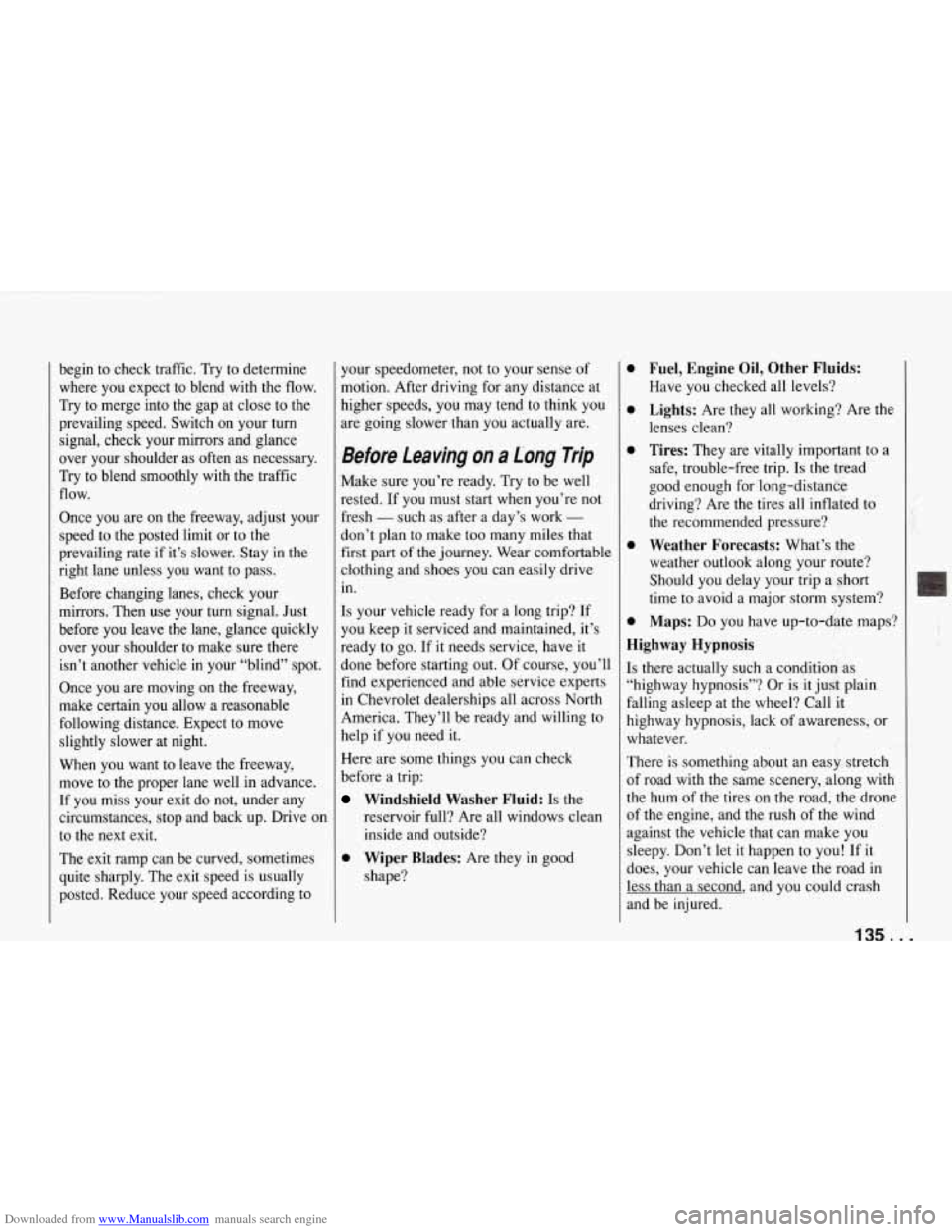
Downloaded from www.Manualslib.com manuals search engine begin to check traffic. Try to determine
where you expect to blend with the flow.
Try to merge into the gap
at close to the
prevailing speed. Switch on your turn
signal, check your mirrors and glance
over your shoulder as often as necessary.
Try to blend smoothly with the traffic
flow.
Once you are on the freeway, adjust your
speed to the posted limit or to the
prevailing rate if it’s slower. Stay in the
right lane unless you want to pass.
Before changing lanes, check your
mirrors. Then use your turn signal. Just
before you leave the lane, glance quickly
over your shoulder to make sure there
isn’t another vehicle in your “blind” spot.
Once you are moving on the freeway,
make certain you allow a reasonable
following distance. Expect to move
slightly slower at night.
When you want to leave the freeway,
move to the proper lane well
in advance.
If you miss your exit do not, under any
circumstances, stop and back up. Drive on
to the next exit.
The exit ramp can be curved, sometimes
quite sharply. The exit speed is usually
posted. Reduce your speed according to your speedometer, not
to your sense of
motion. After driving for any distance at
higher speeds, you may tend to think you
are going slower than you actually are.
Before Leaving on a Long Trip
Make sure you’re ready. Try to be well
rested. If you must start when you’re not
fresh
- such as after a day’s work -
don’t plan to ,make too many miles that
first part
of the journey. Wear comfortable
clothing and shoes you can easily drive
in.
Is your vehicle ready for a long trip? If
you keep it serviced and maintained, it’s
ready to go. If it needs service, have it
done before starting out. Of course, you’ll
find experienced and able service experts
in Chevrolet dealerships all across North
America. They’ll be ready and willing to
help if you need
it.
Here are some things you can check
before a trip:
Windshield Washer Fluid: Is the
reservoir full? Are all windows clean
inside and outside?
0 Wiper Blades: Are they in good
shape?
0
0
Fuel, Engine Oil, Other Fluids:
Have you checked all levels?
Lights: Are they all working? Are the
lenses clean?
Tires: They are vitally important to a
safe, trouble-free trip.
Is the wead
good enough for long-distance
driving? Are the tires all inflated to
the recommended pressure?
Weather Forecasts: What’s the
weather outlook along your route?
Should you delay your trip
a short
time to avoid a major storm system?
Maps: Do you have up-to-date maps?
Highway Hypnosis
Is there actually such a condition as
“highway hypnosis”? Or is it jugt plain
falling asleep at the wheel? Call it
highway hypnosis, lack of awareness, or
whatever.
There is something about an easy stretch
of road with the same scenery, along with
the hum of the tires on the road, the drone
of the engine, and the rush of the wind
against the vehicle that can make you
sleepy. Don’t let it happen to you! If it
does, your vehicle can leave the road in
less than a second, and you could crash
and be injured.
135
Page 138 of 274
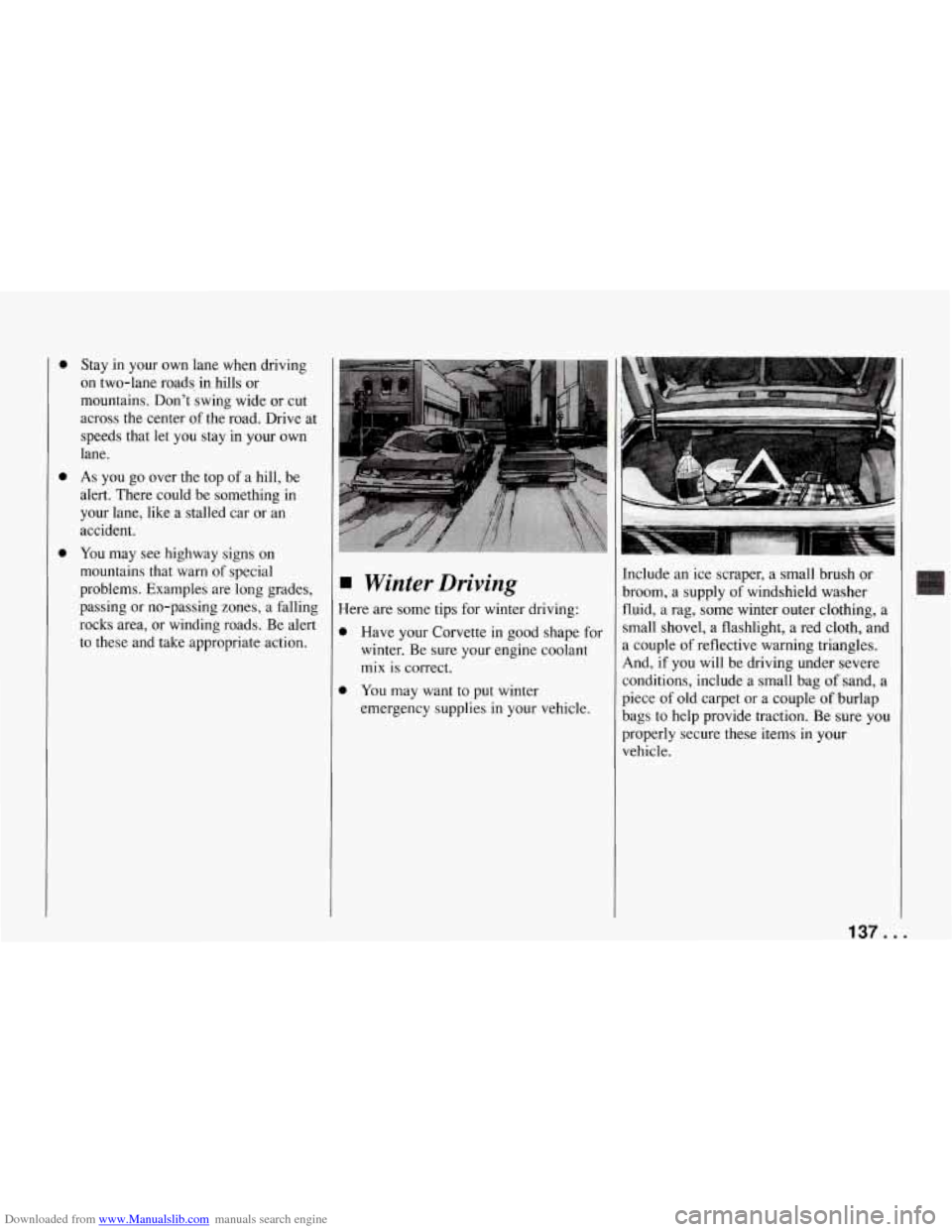
Downloaded from www.Manualslib.com manuals search engine 0
0
0
Stay in your own lane when driving
on two-lane roads. in hills or
mountains. Don't swing wide or cut
across the center of the road. Drive at speeds that let you stay in your own
lane.
As you go over the top of a hill, be
alert. There could be something in
your lane, like
a stalled car or an
accident.
You may see highway signs on
mountains
that warn of special
problems. Examples are long grades,
passing or no-passing zones, a falling
rocks area, or winding roads. Be alert
to these and take appropriate action.
0
0
Winter Driving
Here are some tips for winter driving:
Have your Corvette in good shape for
winter. Be sure your engine coolant
mix
is correct.
You may want to put winter
emergency supplies in your vehicle.
I ,,;;. &_ $*>;.$ , x; ':. . , ;"!d i
Include an ice scraper, a small brush or
broom, a supply of windshield washer
fluid, a rag, some winter outer clothing, a
small shovel, a flashlight, a red cloth, and
a couple
of reflective warning triangles.
And,
if you will be driving under severe
conditions, include a small bag
of sand, a
piece of old carpet or a couple
of burlap
bags to help provide traction. Be sure you
properly secure these items
in your
vehicle.
137 ...
Page 140 of 274
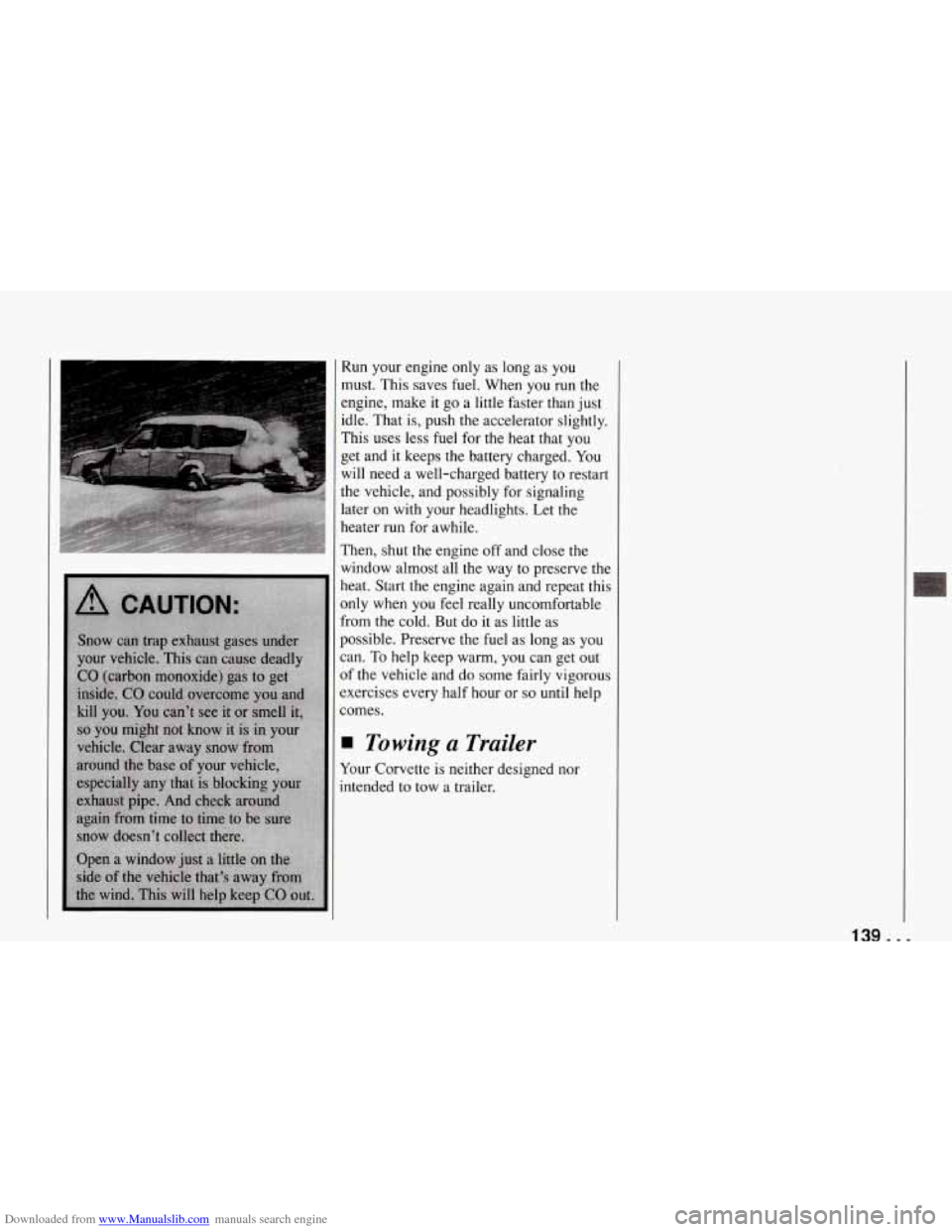
Downloaded from www.Manualslib.com manuals search engine Run your engine only as long as you
must. This saves fuel. When you run the
engine, make it go a little faster than just
idle. That is, push the accelerator slightly.
This uses less fuel for the heat that you
get and it keeps the battery charged. You
will need a well-charged battery to restart
the vehicle, and possibly for signaling
later on with your headlights. Let the
heater run for awhile.
Then, shut the engine
off and close the
window almost all the way to preserve the
heat. Start the engine again and repeat this
only when you feel really uncomfortable
from the cold. But do it as little as
possible. Preserve the fuel as long as you
can.
To help keep warm, you can get out
of the vehicle and do some fairly vigorous
exercises every half hour or
so until help
comes.
Towing a Trailer
Your Corvette is neither designed nor
intended to tow a trailer.
139 ...
Page 143 of 274
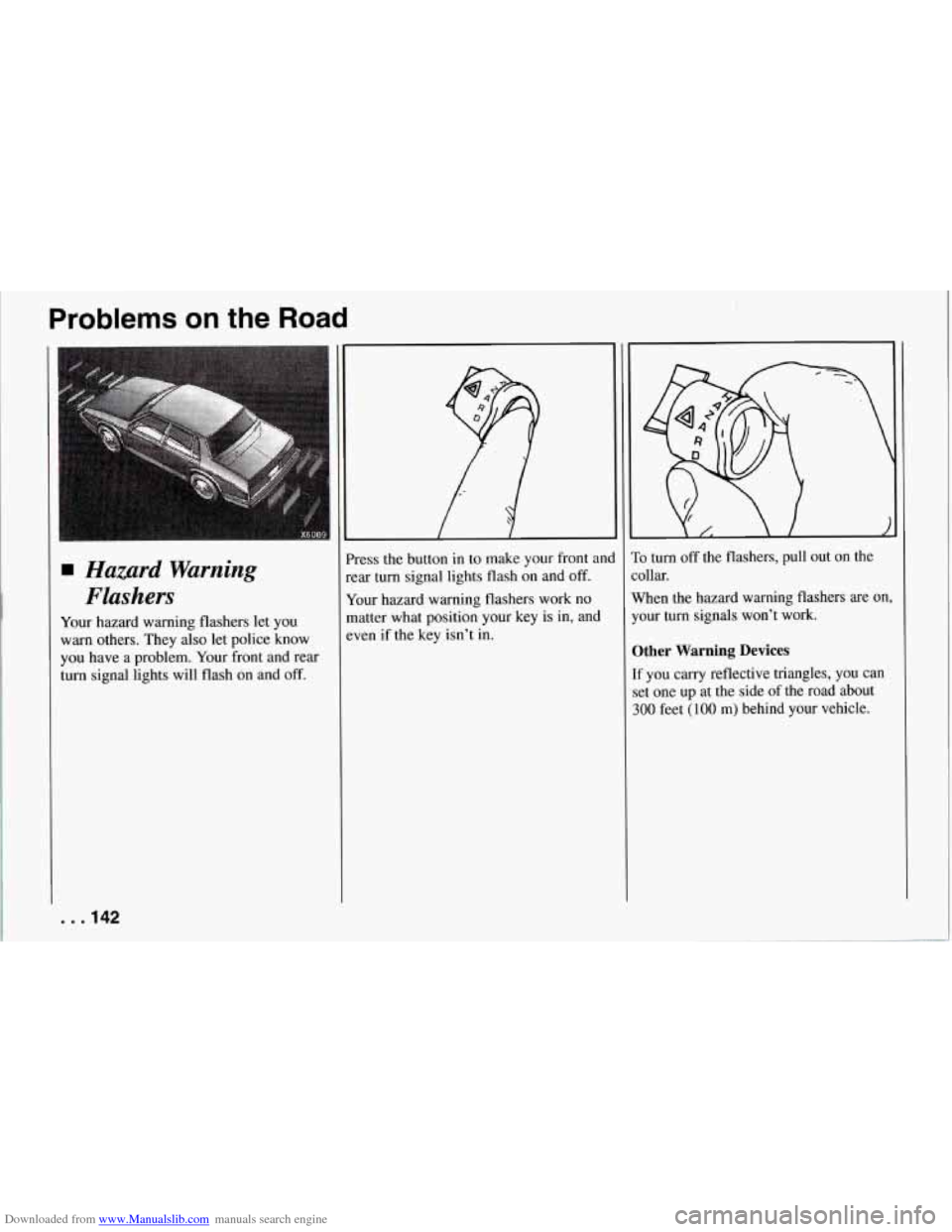
Downloaded from www.Manualslib.com manuals search engine Problems on the Road
Hazard Warning
Flashers
Your hazard warning flashers let you
warn others. They also let police know
you have a problem. Your front and rear
turn signal lights will flash on and off.
'ress the button in to make your front an(
:ar turn signal lights flash on and off.
lour hazard warning flashers work no
matter what position your
key is in, and
ven if the key isn't in.
'0 turn off the flashers, pull out on the
ollar.
Vhen the hazard warning flashers are
on,
'our turn signals won't work.
Ither Warning Devices
f you carry reflective triangles, you can
et one up at the side of the road about
100 feet (100 m) behind your vehicle.
. . .I42
Page 144 of 274
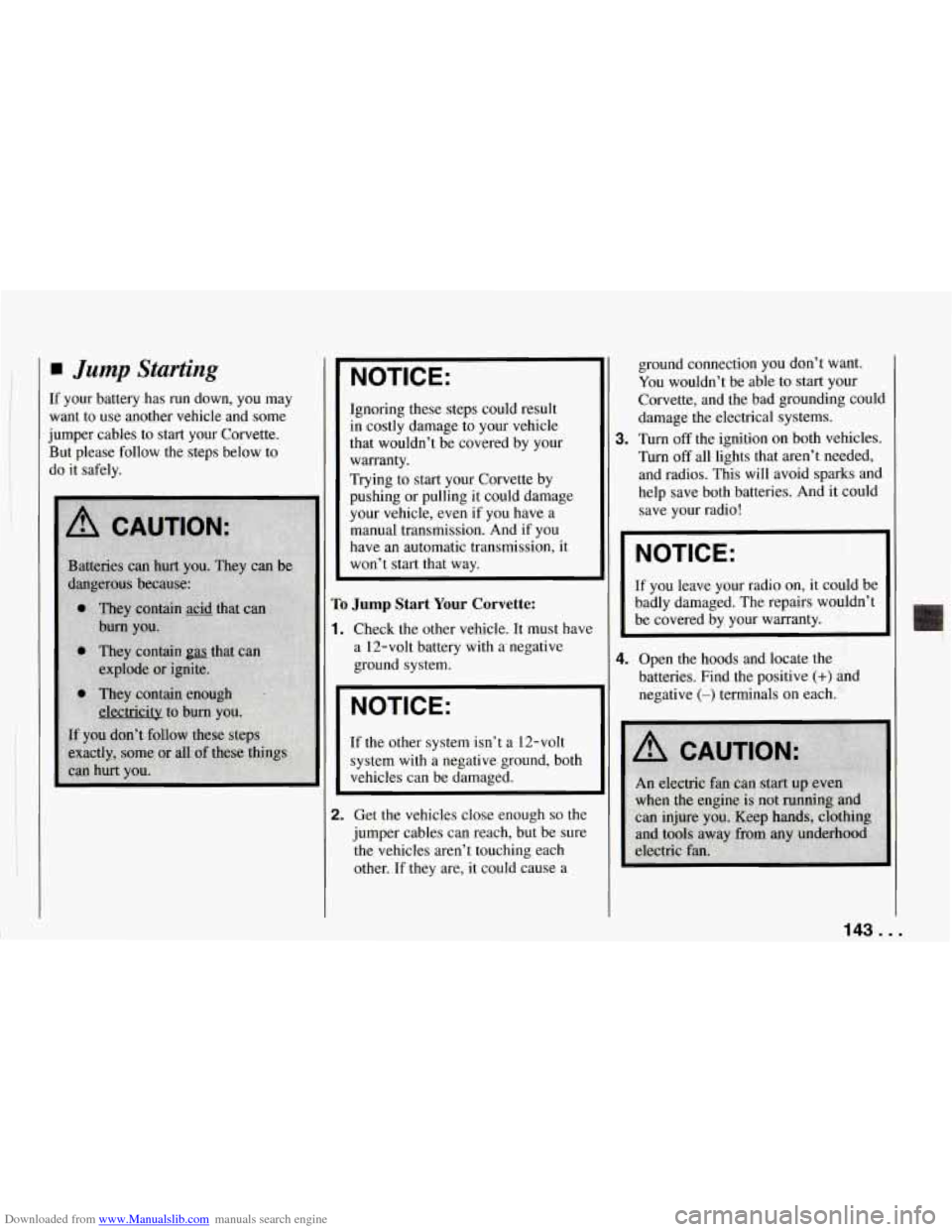
Downloaded from www.Manualslib.com manuals search engine 1 Jump Starting
If your battery has run down, you may
want to use another vehicle and some
jumper cables to start your Corvette.
But please follow the steps below to
do it safely.
NOTICE:
Ignoring these steps could result
in costly damage to your vehicle
that wouldn’t be covered by your
warranty.
Trying to start your Corvette by
pushing or pulling it could damage
your vehicle,
even if you have a
manual transmission. And if you
have an automatic transmission, it
won’t start that way.
Ib Jump Start Your Corvette:
1. Check the other vehicle. It must have
a 12-volt battery with a- negative
ground system.
NOTICE:
If the other system isn’t a 12-volt
system with a negative ground, both
vehicles can be damaged.
2. Get the vehicles close enough so the
jumper cables can reach, but be sure
the vehicles aren’t touching each
other. If they are, it could cause a ground connection you don’t
want.
You wouldn’t be able to start your
Corvette, and the bad grounding could
damage the electrical systems.
3. Turn off the ignition on both vehicles.
Turn
off all lights that aren’t needed,
and radios. This will avoid sparks and
help save both batteries. And it could
save your radio!
I NOTICE:
I
If you leave your radio on, it could be
badly damaged. The repairs wouldn’t
be covered by your warranty.
4. Open the hoods and locate the
batteries. Find the positive
(+) and
negative
(-) terminals on each.
143 ...
Page 151 of 274

Downloaded from www.Manualslib.com manuals search engine Problems on the Road
NOTICE:
Towing a vehicle over rough surfaces
could damage a vehicle. Damage
can occur from vehicle-to-ground
or vehicle-to-wheel-lift-equipment.
To help avoid damage, install a
towing dolly and raise vehicle until
adequate clearance
is obtained
between the ground and/or wheel-lift
equipment. Attach
a separate safety chain around the
outboard end of each lower control
arm.
NOTICE:
Do not allow chains to contact
spring, as damage to spring could
result.
Engine Overheating
You will find a engine coolant
temperature gauge on the instrument
cluster and a low coolant light on the
Driver Information Center.
If Steam Is Corning from Your Engine:
. . .I50
Page 167 of 274
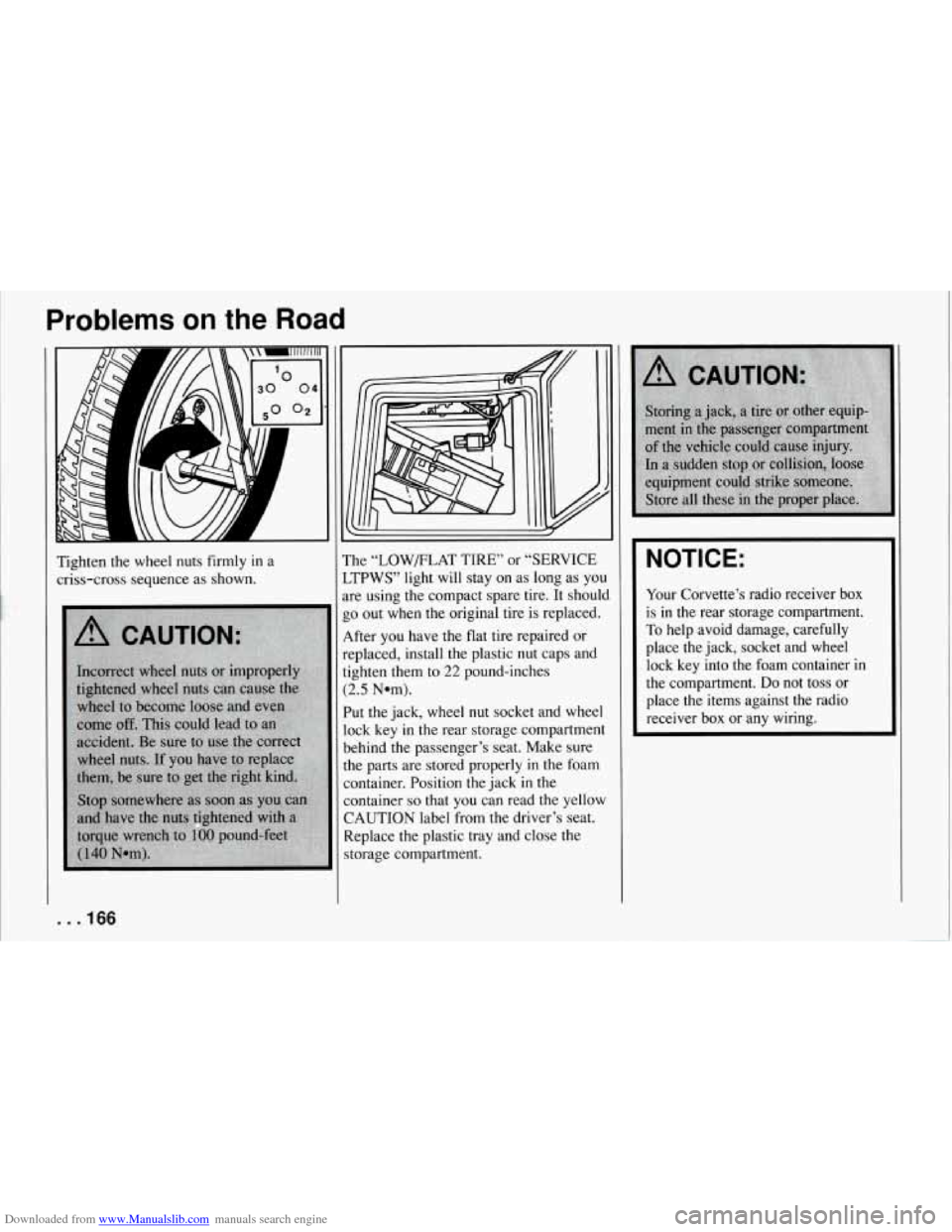
Downloaded from www.Manualslib.com manuals search engine Problems on the Road
Tighten the wheel nuts firmly in a
criss-cross sequence as shown. The
“LOWELAT TIRE” or “SERVICE
LTPWS” light will stay on as long as you
ire using the compact spare tire. It should
50 out when the original tire is replaced.
9fter you have the flat tire repaired or
eeplaced, install the plastic
nut caps and
lighten them to
22 pound-inches
:2.5 Nom).
Put the jack, wheel nut socket and wheel
.ock
key in the rear storage compartment
3ehind the passenger’s seat. Make sure
:he parts are stored properly
in the foam
Zontainer. Position the jack in the
Zontainer
so that you can read the yellow
CAUTION label from
the driver’s seat.
Replace the plastic tray
and close the
storage compartment.
NOTICE:
Your Corvette’s radio receiver box
is in the rear storage compartment.
To help avoid damage, carefully
place the jack, socket and wheel
lock key into the foam container
in
the compartment. Do not toss or
place the items against the radio
receiver
box or any wiring.
. . .I66
Page 171 of 274
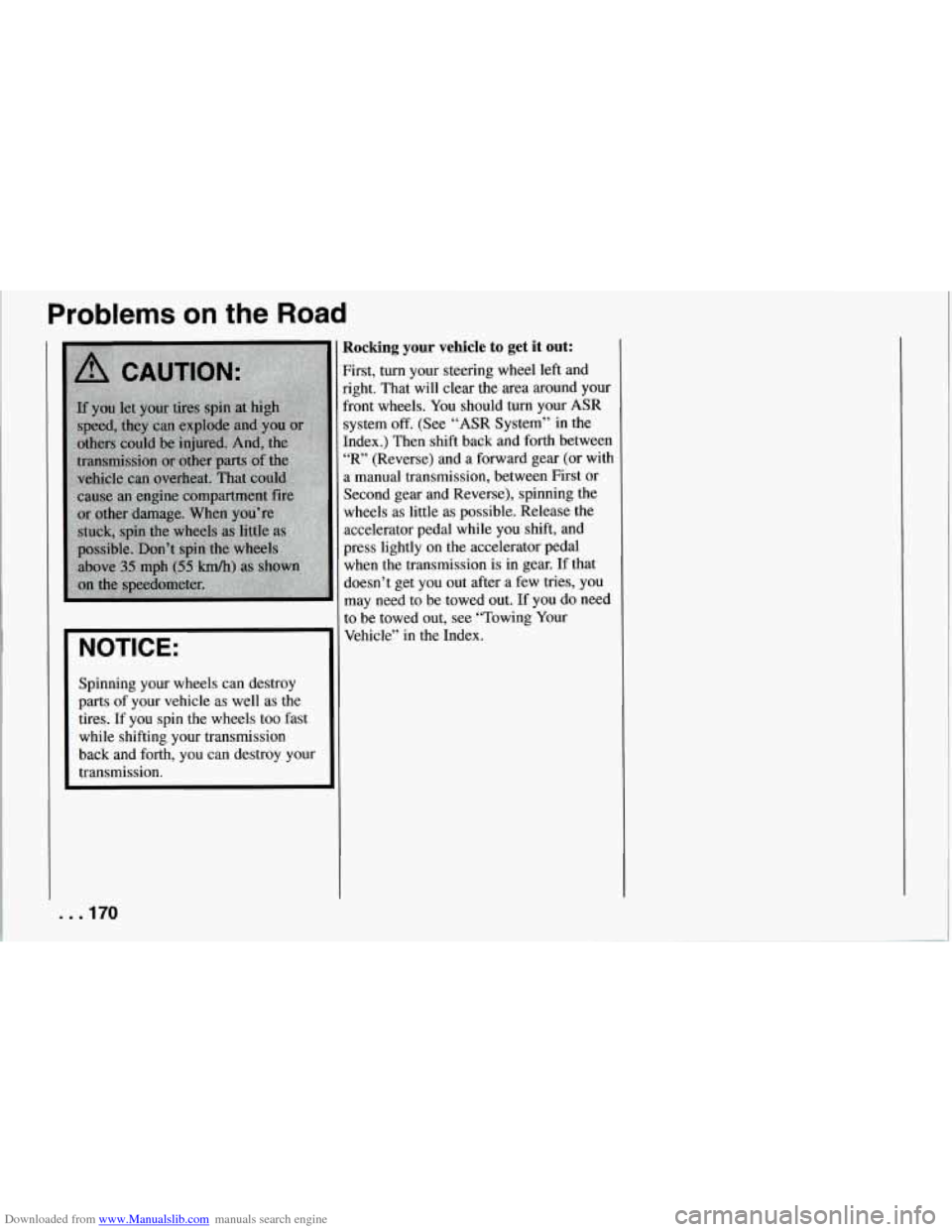
Downloaded from www.Manualslib.com manuals search engine Problems on the Road
NOTICE:
Spinning your wheels can destroy
parts of your vehicle as well as the
tires. If you spin the wheels too fast
while shifting your transmission
back and forth, you can destroy your
transmission.
. . .I70
Rocking your vehicle to get it out:
First, turn your steering wheel left and
ight. That will clear the area around your
front wheels. You should
turn your ASR
system
off. (See “ASR System” in the
[ndex.) Then shift back and forth between
“R’ (Reverse) and a forward gear (or with
9 manual transmission, between First or
Second gear and Reverse), spinning the
wheels as little as possible. Release the
accelerator pedal while you shift, and
press lightly on the accelerator pedal
when the transmission is in gear. If that
doesn’t get you out after a few tries, you
may need to be towed out.
If you do need
to be towed out, see “Towing Your
Vehicle” in the Index.